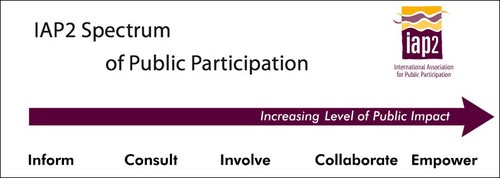
You have a major project or campaign that is not only important to your company, it is also important to the public on various levels. Perhaps some people will be very happy about it, perhaps some won’t be happy at all. Perhaps local residents will be impacted – and therefore local politicians may become keenly interested.
You need a sound communications effort – one that makes people aware of what you’re planning and the benefits of your project. But what kind of communications campaign you develop is critical. In some cases it may be focused on getting information out – to make facts known, to help dispel rumours or make benefits known.
If you’re encouraging public feedback (which you always should), the International Association of Public Participation (IAP2) would classify this approach on its Spectrum of Public Participation as either “Inform” or “Consult.”

As you move further to the right on the Spectrum toward “Involve,” “Collaborate” and “Empower,” the level of public participation increases – up to the point where the public has full decision-making power (one example of this would be an Election).
Interactive public engagement – that is, informed discussion among citizens that is designed to contribute to decision-making – can be implemented successfully in a variety of situations and tends to lead to sustainable solutions.
If your project in any way impacts, involves or will be seen by the public, they will have an interest in it. They will become involved according to each individual’s perception of how seriously they will be personally impacted.
Here is a suggested worksheet to help you consider whether your project or campaign needs a communications focus (we’ll keep people informed but we’ll make all the decisions) or more of a public participation focus (involve members of public in some or all decisions). The example we’ve provided is one we worked on with a client planning a new health care policy in western Canada.
Worksheet
Check the appropriate boxes for questions 1-8 then follow instructions in the left column.
Score indicates
1-2 Very Low to Low
2-3 Low to Moderate – recommendation: at least Consult
3-4 Moderate to High – recommendation: probably Involve
4-5 High to Very High – recommendation: minimum Involve, consider opportunities for Collaborate or Empower if feasible
| Assessment Questions | Very Low | Low | Moderate | High | Very High |
| 1. What is the legally required level of public participation? | X | ||||
| 2. To what extent do we believe the public could help improve the outcome of the project or decisions? | X | ||||
| 3. At what level do we perceive public interest in this project? | X | ||||
| 4. What is the potential for the public to influence the decision-making process? | X | ||||
| 5. What level of media interest do we expect? | X | ||||
| 6. What is the likelihood that decision-makers will give full consideration to public input? | X | ||||
| 7. What levels of resources are likely to be available to support public participation? | X | ||||
| 8. What is the anticipated level for political controversy? | X | ||||
| Count the number of checks in each column | 1 | 4 | 2 | 0 | 1 |
| Multiply the number of checks by the weight | x1 | x2 | x3 | x4 | x5 |
| Enter column score | 1 | 8 | 6 | 0 | 5 |
| Add the total of all five column scores | 20 | ||||
| Divide the total score by the number of questions | /8 | ||||
| 2.5 | |||||